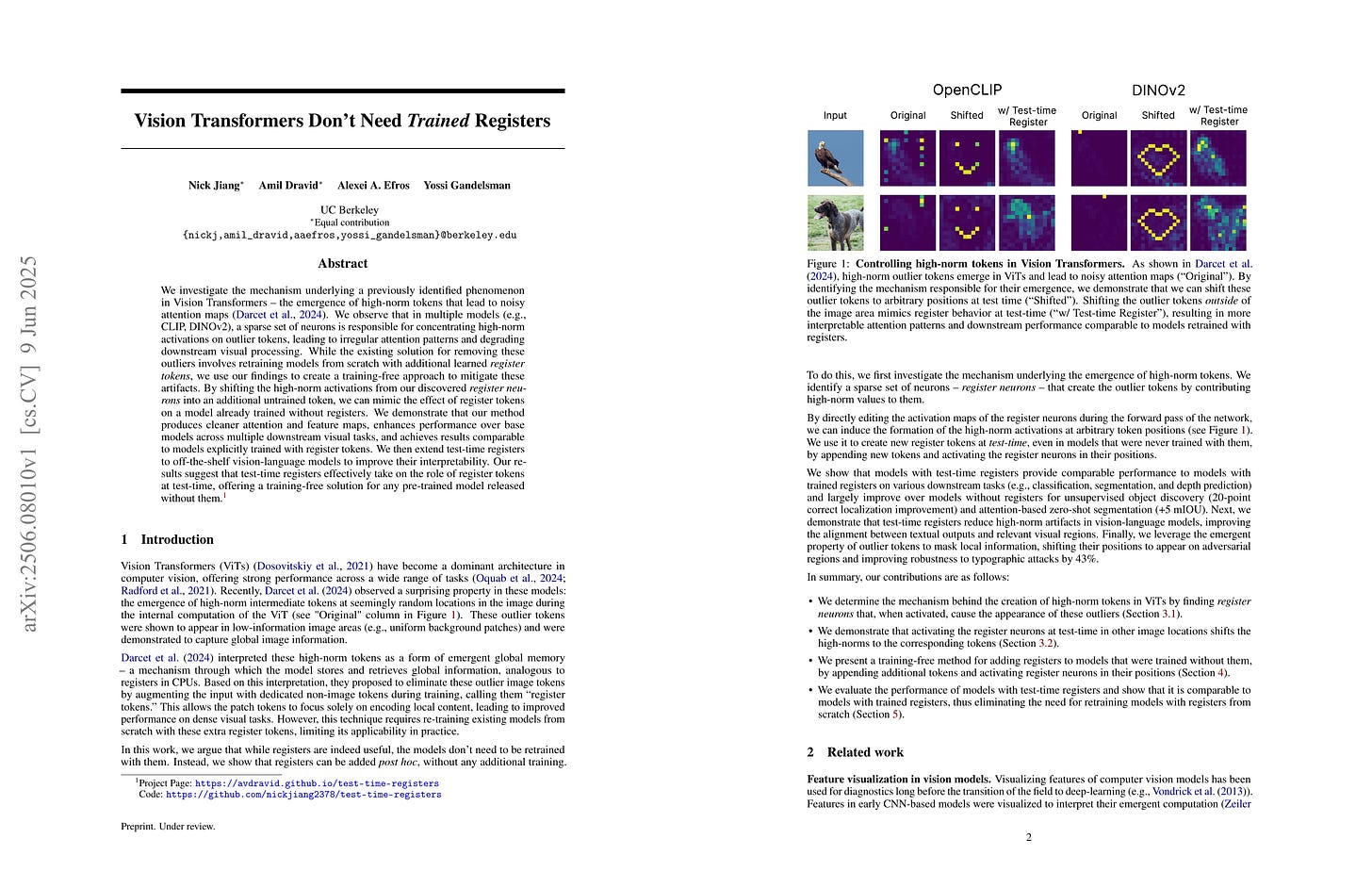2025년 6월 11일
Vision Transformers Don't Need Trained Registers
(Nick Jiang, Amil Dravid, Alexei Efros, Yossi Gandelsman)
We investigate the mechanism underlying a previously identified phenomenon in Vision Transformers -- the emergence of high-norm tokens that lead to noisy attention maps. We observe that in multiple models (e.g., CLIP, DINOv2), a sparse set of neurons is responsible for concentrating high-norm activations on outlier tokens, leading to irregular attention patterns and degrading downstream visual processing. While the existing solution for removing these outliers involves retraining models from scratch with additional learned register tokens, we use our findings to create a training-free approach to mitigate these artifacts. By shifting the high-norm activations from our discovered register neurons into an additional untrained token, we can mimic the effect of register tokens on a model already trained without registers. We demonstrate that our method produces cleaner attention and feature maps, enhances performance over base models across multiple downstream visual tasks, and achieves results comparable to models explicitly trained with register tokens. We then extend test-time registers to off-the-shelf vision-language models to improve their interpretability. Our results suggest that test-time registers effectively take on the role of register tokens at test-time, offering a training-free solution for any pre-trained model released without them.
ViT의 아웃라이어 토큰을 임의의 위치로 이동시키는 방법을 연구했군요. 아예 이미지 밖으로 제외시키면 레지스터 토큰처럼 기능하게 된다고.
This study explores a method of relocating outlier tokens in ViT to arbitrary positions. Interestingly, when these tokens are moved completely outside the image, they begin to function similarly to register tokens.
#vit #transformer
MiniCPM4: Ultra-Efficient LLMs on End Devices
(MiniCPM Team)
This paper introduces MiniCPM4, a highly efficient large language model (LLM) designed explicitly for end-side devices. We achieve this efficiency through systematic innovation in four key dimensions: model architecture, training data, training algorithms, and inference systems. Specifically, in terms of model architecture, we propose InfLLM v2, a trainable sparse attention mechanism that accelerates both prefilling and decoding phases for long-context processing. Regarding training data, we propose UltraClean, an efficient and accurate pre-training data filtering and generation strategy, and UltraChat v2, a comprehensive supervised fine-tuning dataset. These datasets enable satisfactory model performance to be achieved using just 8 trillion training tokens. Regarding training algorithms, we propose ModelTunnel v2 for efficient pre-training strategy search, and improve existing post-training methods by introducing chunk-wise rollout for load-balanced reinforcement learning and data-efficient tenary LLM, BitCPM. Regarding inference systems, we propose CPM.cu that integrates sparse attention, model quantization, and speculative sampling to achieve efficient prefilling and decoding. To meet diverse on-device requirements, MiniCPM4 is available in two versions, with 0.5B and 8B parameters, respectively. Sufficient evaluation results show that MiniCPM4 outperforms open-source models of similar size across multiple benchmarks, highlighting both its efficiency and effectiveness. Notably, MiniCPM4-8B demonstrates significant speed improvements over Qwen3-8B when processing long sequences. Through further adaptation, MiniCPM4 successfully powers diverse applications, including trustworthy survey generation and tool use with model context protocol, clearly showcasing its broad usability.
MiniCPM 모델이 나왔군요. Sparse Attention을 사용했네요. 데이터셋 구축 과정이나 μP와 하이퍼파라미터 Scaling Law의 비교도 흥미롭습니다.
The new MiniCPM model has been released. They've employed sparse attention. The dataset construction process and the comparison with μP and hyperparameter scaling laws are also interesting.
#llm #scaling-law #hyperparameter #efficient-attention
Reinforcement Pre-Training
(Qingxiu Dong, Li Dong, Yao Tang, Tianzhu Ye, Yutao Sun, Zhifang Sui, Furu Wei)
In this work, we introduce Reinforcement Pre-Training (RPT) as a new scaling paradigm for large language models and reinforcement learning (RL). Specifically, we reframe next-token prediction as a reasoning task trained using RL, where it receives verifiable rewards for correctly predicting the next token for a given context. RPT offers a scalable method to leverage vast amounts of text data for general-purpose RL, rather than relying on domain-specific annotated answers. By incentivizing the capability of next-token reasoning, RPT significantly improves the language modeling accuracy of predicting the next tokens. Moreover, RPT provides a strong pre-trained foundation for further reinforcement fine-tuning. The scaling curves show that increased training compute consistently improves the next-token prediction accuracy. The results position RPT as an effective and promising scaling paradigm to advance language model pre-training.
다음 토큰 예측에 추론 RL을 그대로 적용했군요. 다음 토큰을 예측하려고 애쓰는 게 귀엽네요.
They've directly applied reasoning RL to next token prediction. It's cute to see the model trying so hard to predict the next tokens.
#reasoning #rl
Solving Inequality Proofs with Large Language Models
(Jiayi Sheng, Luna Lyu, Jikai Jin, Tony Xia, Alex Gu, James Zou, Pan Lu)
Inequality proving, crucial across diverse scientific and mathematical fields, tests advanced reasoning skills such as discovering tight bounds and strategic theorem application. This makes it a distinct, demanding frontier for large language models (LLMs), offering insights beyond general mathematical problem-solving. Progress in this area is hampered by existing datasets that are often scarce, synthetic, or rigidly formal. We address this by proposing an informal yet verifiable task formulation, recasting inequality proving into two automatically checkable subtasks: bound estimation and relation prediction. Building on this, we release IneqMath, an expert-curated dataset of Olympiad-level inequalities, including a test set and training corpus enriched with step-wise solutions and theorem annotations. We also develop a novel LLM-as-judge evaluation framework, combining a final-answer judge with four step-wise judges designed to detect common reasoning flaws. A systematic evaluation of 29 leading LLMs on IneqMath reveals a surprising reality: even top models like o1 achieve less than 10% overall accuracy under step-wise scrutiny; this is a drop of up to 65.5% from their accuracy considering only final answer equivalence. This discrepancy exposes fragile deductive chains and a critical gap for current LLMs between merely finding an answer and constructing a rigorous proof. Scaling model size and increasing test-time computation yield limited gains in overall proof correctness. Instead, our findings highlight promising research directions such as theorem-guided reasoning and self-refinement. Code and data are available at
https://ineqmath.github.io/
.
자연어 기반 부등식 증명 벤치마크. 자연어 기반이라서 평가가 문제이긴 합니다.
A benchmark for natural language-based inequality proofs. Natural language induces challenges in evaluation.
#math #benchmark
A Stable Whitening Optimizer for Efficient Neural Network Training
(Kevin Frans, Sergey Levine, Pieter Abbeel)
In this work, we take an experimentally grounded look at neural network optimization. Building on the Shampoo family of algorithms, we identify and alleviate three key issues, resulting in the proposed SPlus method. First, we find that naive Shampoo is prone to divergence when matrix-inverses are cached for long periods. We introduce an alternate bounded update combining a historical eigenbasis with instantaneous normalization, resulting in across-the-board stability and significantly lower computational requirements. Second, we adapt a shape-aware scaling to enable learning rate transfer across network width. Third, we find that high learning rates result in large parameter noise, and propose a simple iterate-averaging scheme which unblocks faster learning. To properly confirm these findings, we introduce a pointed Transformer training benchmark, considering three objectives (language modelling, image classification, and diffusion modelling) across different stages of training. On average, SPlus is able to reach the validation performance of Adam within 44% of the gradient steps and 62% of the wallclock time.
Shampoo의 개선. Shampoo를 안정화시키고 Hyperparameter Transfer, 그리고 EMA를 추가했네요. EMA가 추가되어서 비교가 어렵긴 하군요.
An improvement on Shampoo. They stabilized Shampoo, added hyperparameter transfer, and incorporated EMA. The addition of EMA makes fair comparison somewhat difficult.
#optimizer
Spark Transformer: Reactivating Sparsity in FFN and Attention
(Chong You, Kan Wu, Zhipeng Jia, Lin Chen, Srinadh Bhojanapalli, Jiaxian Guo, Utku Evci, Jan Wassenberg, Praneeth Netrapalli, Jeremiah J. Willcock, Suvinay Subramanian, Felix Chern, Alek Andreev, Shreya Pathak, Felix Yu, Prateek Jain, David E. Culler, Henry M. Levy, Sanjiv Kumar)
The discovery of the lazy neuron phenomenon in trained Transformers, where the vast majority of neurons in their feed-forward networks (FFN) are inactive for each token, has spurred tremendous interests in activation sparsity for enhancing large model efficiency. While notable progress has been made in translating such sparsity to wall-time benefits, modern Transformers have moved away from the ReLU activation function crucial to this phenomenon. Existing efforts on re-introducing activation sparsity often degrade model quality, increase parameter count, complicate or slow down training. Sparse attention, the application of sparse activation to the attention mechanism, often faces similar challenges. This paper introduces the Spark Transformer, a novel architecture that achieves a high level of activation sparsity in both FFN and the attention mechanism while maintaining model quality, parameter count, and standard training procedures. Our method realizes sparsity via top-k masking for explicit control over sparsity level. Crucially, we introduce statistical top-k, a hardware-accelerator-friendly, linear-time approximate algorithm that avoids costly sorting and mitigates significant training slowdown from standard top-k operators. Furthermore, Spark Transformer reallocates existing FFN parameters and attention key embeddings to form a low-cost predictor for identifying activated entries. This design not only mitigates quality loss from enforced sparsity, but also enhances wall-time benefit. Pretrained with the Gemma-2 recipe, Spark Transformer demonstrates competitive performance on standard benchmarks while exhibiting significant sparsity: only 8% of FFN neurons are activated, and each token attends to a maximum of 256 tokens. This sparsity translates to a 2.5x reduction in FLOPs, leading to decoding wall-time speedups of up to 1.79x on CPU and 1.40x on GPU.
Top-K Activation의 효율적인 근사를 사용한 Sparse Transformer.
A sparse transformer utilizing an efficient approximation of top-K activation.
#transformer #sparsity
Boosting LLM Reasoning via Spontaneous Self-Correction
(Xutong Zhao, Tengyu Xu, Xuewei Wang, Zhengxing Chen, Di Jin, Liang Tan, Yen-Ting, Zishun Yu, Zhuokai Zhao, Yun He, Sinong Wang, Han Fang, Sarath Chandar, Chen Zhu)
While large language models (LLMs) have demonstrated remarkable success on a broad range of tasks, math reasoning remains a challenging one. One of the approaches for improving math reasoning is self-correction, which designs self-improving loops to let the model correct its own mistakes. However, existing self-correction approaches treat corrections as standalone post-generation refinements, relying on extra prompt and system designs to elicit self-corrections, instead of performing real-time, spontaneous self-corrections in a single pass. To address this, we propose SPOC, a spontaneous self-correction approach that enables LLMs to generate interleaved solutions and verifications in a single inference pass, with generation dynamically terminated based on verification outcomes, thereby effectively scaling inference time compute. SPOC considers a multi-agent perspective by assigning dual roles -- solution proposer and verifier -- to the same model. We adopt a simple yet effective approach to generate synthetic data for fine-tuning, enabling the model to develop capabilities for self-verification and multi-agent collaboration. We further improve its solution proposal and verification accuracy through online reinforcement learning. Experiments on mathematical reasoning benchmarks show that SPOC significantly improves performance. Notably, SPOC boosts the accuracy of Llama-3.1-8B and 70B Instruct models, achieving gains of 8.8% and 11.6% on MATH500, 10.0% and 20.0% on AMC23, and 3.3% and 6.7% on AIME24, respectively.
Proposer와 Verifier의 멀티 에이전트 세팅으로 모델이 응답을 자기 수정하도록 한 방법. 이전에 모델이 Revision을 하도록 시도한 방법들과 비슷하네요.
This method employs a multi-agent setting with a proposer and a verifier, to enable the model to self-correct its responses. It appears similar to previous approaches that attempted to make models revise their outputs.
#reasoning #rl
Magistral
(Mistral.AI)
We introduce Magistral, Mistral’s first reasoning model and our own scalable reinforcement learning (RL) pipeline. Instead of relying on existing implementations and RL traces distilled from prior models, we follow a ground up approach, relying solely on our own models and infrastructure. Notably, we demonstrate a stack that enabled us to explore the limits of pure RL training of LLMs, present a simple method to force the reasoning language of the model, and show that RL on text data alone maintains most of the initial checkpoint’s capabilities. We find that RL on text maintains or improves multimodal understanding, instruction following and function calling. We present Magistral Medium, trained for reasoning on top of Mistral Medium 3 with RL alone, and we open-source Magistral Small (Apache 2.0) which further includes cold-start data from Magistral Medium.
Mistral의 추론 모델. 요즘 기준으로는 정석적인 세팅이군요. 추가적으로 비동기 생성을 채택.
Mistral's reasoning model. It uses conventional settings by current standards. Additionally, it adopts asynchronous generation.
#reasoning #rl












